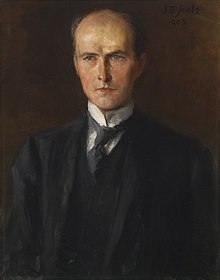John Quinn | |
|---|---|
 John Quinn by John Butler Yeats, 1908 | |
| Born | April 14, 1870 |
| Died | July 28, 1924 (aged 54) |
| Alma mater | University of Michigan |
| Occupation(s) | American lawyer and art collector |
John Quinn (April 14, 1870 in Tiffin, Ohio – July 28, 1924 in Fostoria, Ohio)[1] was an Irish-American cognoscente of the art world and a lawyer in New York City who fought to overturn censorship laws restricting modern literature and art from entering the United States.[2][better source needed]
Quinn was an important patron of chief figures in Post-Impressionism and literary Modernism, a major collector of modern art and original manuscripts, and the first to exhibit these works after winning legal battles against censorship and cultural isolation. In the 1920s he owned the largest single collection of modern European paintings in the world. He fought key legal battles that opened American culture to 20th century art movements, including his Congressional appeals to overturn the Payne–Aldrich Tariff Act.
He was part of the group who staged the Armory Show in 1913, the first great exhibition of European and American modern art in the United States, at the 69th Regiment Armory in New York. Quinn gave practical advice and financial assistance to Ezra Pound and T.S. Eliot. In gratitude, Eliot sent Quinn the original manuscript of his 1922 poem The Waste Land, including Pound's editorial suggestions.[3]
- ^ Dixon, Kathleen (2015-04-24). "In Tiffin, Ohio, 145 years ago, on April 24, 1870… | SuchFriends Blog". Suchfriends.wordpress.com. Retrieved 2017-03-16.
- ^ "Bloomsday: Court finds Ulysses obscene", New York Irish Arts, June 23, 2012.
- ^ The Waste Land: a facsimile & transcript of the original drafts, edited by Valerie Eliot, 2012, p. xxxi.